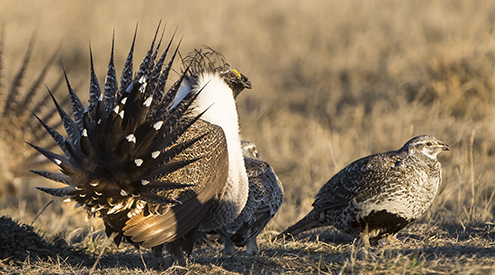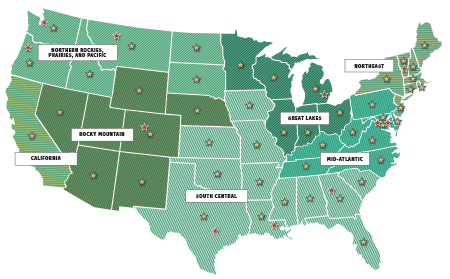The sagebrush steppe isn’t always the most well-known or photographed western landscape, but it’s a striking panorama of silver-green bushes and other vegetation that is home to more than 350 species. Greater sage-grouse are among those species and the one that has trained the spotlight on what is often called the sagebrush sea.
 State and federal wildlife and land managers, private landowners, sportsmen and women have undertaken an unprecedented, multi-state conservation campaign to conserve the greater sage-grouse, a chicken-size bird with spiky tail feathers. Greater sage-grouse once numbered as high as 16 million across the western U.S. and parts of Canada. Drought, wildfires, invasive species choking out native plants needed by grouse, vegetation plowed under for crops, urbanization, and energy development have degraded and cut the bird’s habitat by more than half. Best estimates put the bird’s current total population at fewer than a half million across 11 western states.
State and federal wildlife and land managers, private landowners, sportsmen and women have undertaken an unprecedented, multi-state conservation campaign to conserve the greater sage-grouse, a chicken-size bird with spiky tail feathers. Greater sage-grouse once numbered as high as 16 million across the western U.S. and parts of Canada. Drought, wildfires, invasive species choking out native plants needed by grouse, vegetation plowed under for crops, urbanization, and energy development have degraded and cut the bird’s habitat by more than half. Best estimates put the bird’s current total population at fewer than a half million across 11 western states.
The goal of the work by states, the Bureau of Land Management, ranchers and other landowners and the USDA Natural Resources Conservation Service is to save the greater sage-grouse, an iconic western species that performs elaborate mating dances each spring on the same breeding grounds, or leks. To save the bird, we have to save its habitat, which also sustains such cherished animals as mule deer, pronghorn, and elk. The steppe’s diverse array of grasses and forbs provide shelter to songbirds, pygmy rabbits, and lizards. Ferruginous hawks and golden eagles soar above the wide open spaces and swoop down for food.
Sportsmen and women and wildlife advocates understand the health of sage grouse populations is a barometer of the overall health of the sagebrush steppe and has implications for many other species. In other words, if you save the bird, you save the herd.
“Not everyone appreciates the beauty of sagebrush country, but for those of us who live around it or spend a lot of time there, the sagebrush steppe defines the West as much as any snowcapped mountain peak. It’s teeming with the wildlife that everyone associates with the West.”
—Dave Chadwick, Montana Wildlife Federation Executive Director
“The plight of the greater sage grouse is a loud warning that all is not right on the sagebrush steppe—not only for grouse but for other wildlife, too. Those who depend on the land for their livelihoods or recreate there have an obligation to make sure the sage grouse survives and that sagebrush country will be here for generations to come.”
—Suzanne O’Neill, Colorado Wildlife Federation Executive Director
Take the Clean Earth Challenge and help make the planet a happier, healthier place.
Learn MoreA groundbreaking bipartisan bill aims to address the looming wildlife crisis before it's too late, while creating sorely needed jobs.
Read MoreMore than one-third of U.S. fish and wildlife species are at risk of extinction in the coming decades. We're on the ground in seven regions across the country, collaborating with 52 state and territory affiliates to reverse the crisis and ensure wildlife thrive.
